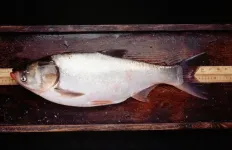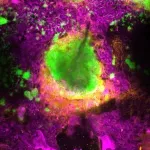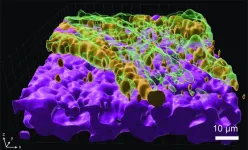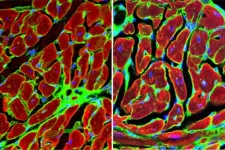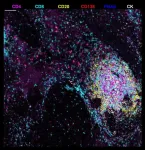(Press-News.org) URBANA, Ill. — Invasive silver carp have been spreading throughout the Mississippi River Basin since their introduction a half-century ago. Yet, try as they might, the fish have not advanced beyond a particular stretch of the Illinois River north of Kankakee. Research from the University of Illinois Urbana-Champaign shows the fish are likely avoiding contaminants from the Chicago Area Waterway, which flows south before petering out around Kankakee.
A new study, published today in Scientific Reports, shows silver carp change their behavior and metabolism when introduced to water from the Illinois River north of Kankakee, representing Chicago-area water.
“When animals experience a stressor, sometimes they'll just get out of there. They think, ‘This is terrible, I'm leaving,’ and they scoot. But sometimes they reduce activity and hunker down. These animals think, ‘I'm just going to ride this out and see if conditions improve.’ When we put the carp in the Chicago water, that's what they did –- they reduced activity and stopped moving,” said study co-author Cory Suski, professor in the Department of Natural Resources and Environmental Sciences (NRES) in the College of Agricultural, Consumer and Environmental Sciences (ACES) at Illinois.
Suski and his colleagues from the University of Texas and the U.S. Geological Survey (USGS) trucked water from north of the Kankakee area to a USGS fish hatchery, where they compared silver carp behavior in water from the Chicago Area Waterway and from the laboratory.
“We’d drop fish in buckets and measure behavior using video cameras,” Suski said. “Fish in the lab water would explore, as if they were thinking, ‘Oh hey, I'm in a new bucket. What's over here?’ Over time, they’d get bored and stop moving, but carp in the Chicago area water slowed activity rates right away, suggesting an element of stress.”
Interestingly, although fish in the Chicago area water moved less, they were also burning more energy than carp in laboratory water. Suski says that shows the fish were likely working overtime to cope with contaminant exposure.
The new behavioral and metabolic findings are consistent with a 2019 study from Suski’s group showing wild silver carp sampled from north of Kankakee were turning on genes related to toxin removal, and turning off genes responsible for DNA repair and protective measures in their livers. Those patterns suggested that the fish were so busy detoxifying contaminants they sacrificed their own internal repair mechanisms.
Neither study identifies what specific contaminants the carp may be reacting to, but it’s clear from a USGS report that a number of Chicago-area contaminants drop off dramatically at the Kankakee-area site.
“Volatile organic compounds, pharmaceuticals, and a ton of other contaminants are all higher upstream, closer to Chicago,” Suski said. “There's a pretty big shift in contaminant concentrations right around this one pool of the Illinois River. Carp are spreading and becoming abundant everywhere else, except in this one spot. And it’s been that way for at least a decade.”
Amy Schneider, lead study author and former NRES graduate student, added, "By studying the physiology and behavior of invasive fish species like silver carp, researchers can continue to improve upon and develop methods of deterring these species."
Although contaminated water appears to be a pretty effective way to keep invasive carp out of the $7 billion Great Lakes fishery, no one is suggesting adding contaminants to prevent carp movement. In fact, Suski says recent efforts to clean the Chicago Area Waterway have been successful, as evidenced by healthier fish communities. But cleaning the water could have unintended consequences for silver carp.
“It’s good that Chicago area water quality is getting better, but the reality is that improving water quality might inadvertently remove the deterrent repelling invasive carp,” Suski said. “Continuing to work on this topic would be beneficial so we can understand why the population front has remained stable for so long and what might happen if the deterrent goes away.”
The article, “Silver carp experience metabolic and behavioral changes when exposed to water from the Chicago Area Waterway,” is published in Scientific Reports. The authors are Amy Schneider, A.J. Esbaugh, Aaron Cupp, and Cory Suski. The research was funded by the U.S. Geological Survey, the USDA National Institute of Food and Agriculture, and the Department of Natural Resources and Environmental Sciences in the College of Agricultural, Consumer and Environmental Sciences at Illinois.
END
Study: Invasive silver carp reduce movement in Chicago-area water
2024-10-25
ELSE PRESS RELEASES FROM THIS DATE:
A lung pathogen’s dilemma: infect or resist antibiotics?
2024-10-25
Imagine trying to settle into a new home while constantly being attacked. That’s what the bacterium Pseudomonas aeruginosa faces when it infects the lungs, and it can’t both spread and protect itself from antibiotics at the same time. Nonetheless, it’s one of the top culprits in hospital-acquired infections and it’s notorious for causing long-lasting, antibiotic-resistant infections, causing damage especially in people with lung diseases like cystic fibrosis, COPD, or bronchiectasis.
To survive tough conditions, P. aeruginosa forms colonies ...
Batteries for miniature bio-integrated devices and robotics — here’s how to do it
2024-10-25
University of Oxford researchers have made a significant step towards realising miniature, soft batteries for use in a variety of biomedical applications, including the defibrillation and pacing of heart tissues. The work has been published today in the journal Nature Chemical Engineering.
The development of tiny smart devices, smaller than a few cubic millimeters, demands equally small power sources. For minimally invasive biomedical devices that interact with biological tissues, these power sources must be fabricated from soft materials. Ideally, these should ...
UCLA researchers uncover novel role of protein GPNMB in heart repair
2024-10-25
FINDINGS
UCLA scientists have identified the protein GPNMB as a critical regulator in the heart’s healing process after a heart attack.
Using animal models, they demonstrate that bone marrow-derived immune cells called macrophages secrete GPNMB, which binds to the receptor GPR39, promoting heart repair. These findings offer a new understanding of how the heart heals itself and could lead to new treatments aimed at improving heart function and preventing the progression to heart failure.
BACKGROUND
Every 40 seconds, ...
Political polarization poses health risks, new analysis concludes
2024-10-25
News coverage of the 2024 election season has often centered on how partisan division has affected our politics. But a new analysis shows that political polarization also poses significant health risks—by obstructing the implementation of legislation and policies aimed at keeping Americans healthy, by discouraging individual action to address health needs, such as getting a flu shot, and by boosting the spread of misinformation that can reduce trust in health professionals.
“Compared to other high-income countries, the United States has a disadvantage when it comes to the health of its citizens,” ...
Lymph node-like structures may trigger the demise of cancer tumors
2024-10-25
**EMBARGOED FOR RELEASE UNTIL OCT. 25 AT 5 A.M. ET**
A newly described stage of a lymph node-like structure seen in liver tumors after presurgical immunotherapy may be vital to successfully treating patients with hepatocellular carcinoma, according to a study by researchers from the Johns Hopkins Kimmel Cancer Center.
The study, published Oct. 25 in Nature Immunology, provides new information about lymph node-like structures called tertiary lymphoid structures. These structures, which are highly organized ...
Pitchers rejoice? Plasma irradiation might prevent tendon re-tears
2024-10-25
The human body, filled with muscles and moving parts, is far from indestructible. Injuries are common, especially where tendons and bones connect. In Japan, rotator cuff tears affect approximately 1 in 4 people over age 50, and reports state that even after surgery, about 20% of cases result in re-tears. To combat this, new healing methods to bolster current clinical practices are needed.
Graduate student Katsumasa Nakazawa, Associate Professor Hiromitsu Toyoda, and then Professor Hiroaki Nakamura at Osaka Metropolitan University’s ...
The clinical significance of microvascular inflammation after kidney transplantation
2024-10-25
San Diego, CA (October 24, 2024) — Investigators recently uncovered key insights into newly defined rejection entities in kidney transplantation that may offer improved patient risk categorization post-transplant. The research will be presented at ASN Kidney Week 2024 October 23– 27.
Kidney transplant rejection continues to threaten the long-term success of kidney transplants, with microvascular inflammation (inflammation within capillaries) playing a pivotal role in graft failure. Due to its complex nature, this inflammation poses a major challenge in clinical practice. In response, the international Banff classification—the ...
The Lancet Public Health: New Commission calls for regulatory reform to tackle the health impacts of the rapid global expansion of commercial gambling
2024-10-24
**Embargo: 23.30 [UK time] / 06.30pm [US ET] Thursday 24th October 2024**
Peer reviewed / Literature review, systematic review and meta-analysis, opinion / People
Embargoed access to the Commission report and contact details for authors are available in Notes to Editors at the end of the release.
The Lancet Public Health: New Commission calls for regulatory reform to tackle the health impacts of the rapid global expansion of commercial gambling
Gambling harms are far more substantial than previously understood, exacerbated by rapid global expansion ...
Scientists create cancer patients’ ‘digital twins’ to predict how well treatments may work
2024-10-24
Barcelona, Spain: Researchers have shown that they can accurately re-create clinical trials of new treatments using ‘digital twins’ of real cancer patients. The technology, called FarrSight®-Twin, which is based on algorithms used by astrophysicists to discover black holes, will be presented today (Friday) at the 36th EORTC-NCI-AACR [1] Symposium on Molecular Targets and Cancer Therapeutics in Barcelona, Spain.
The researchers say that this approach could be used by cancer ...
New ‘mini-protein’ carries radiation dose directly to tumours without harming healthy tissues
2024-10-24
Barcelona, Spain: Researchers have shown for the first time that it is possible for a specially-designed ‘mini-protein’ to deliver a radiation dose directly to tumour cells expressing a protein on their cell surfaces called Nectin-4, which is often found in a number of different cancers.
In a study presented on Friday at the 36th EORTC-NCI-AACR [1] Symposium on Molecular Targets and Cancer Therapeutics in Barcelona, Spain, Mike Sathekge, Professor and Head of the Nuclear Medicine Department at the University of Pretoria ...
